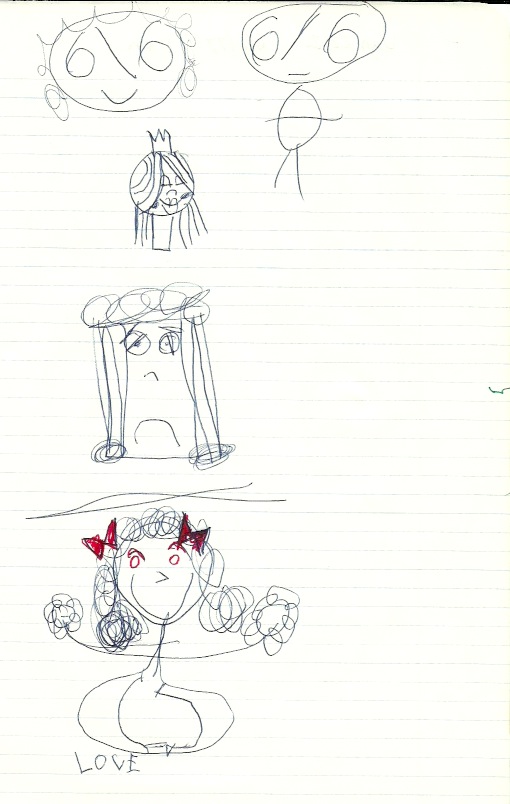Vignette 22.1 | Emberley’s Faces | 6/6/77 |
Miriam’s wheezing was so severe this evening she couldn’t sleep. About 10:30 she came from her room to ask if she could sit up with me because it was so lonely in bed and she didn’t want to read any more.
I brought from my briefcase Ed Emberley’s Drawing Book of Faces, a book we had used in Logo Session 9 (an unsuccessful attempt to engage Miriam in the use of an introductory drawing program). Miriam was delighted to draw with the aid of this book. The first face she drew was “Tired Tillie” from page 5. (How appropriate for a child 2 1/2 hours past her bed time). The second figure (at the top of page 4) has the face of “Happy Harriet.” (Notice the two eye circles were added late, when the hair bows were being colored in). The 6 and 7 fingered hands appear to be a free, somewhat controlled extension of the hair scribble motif. The body is merely indicated and the message is the common one appearing above Miriam’s name on all the notes she prepares and gives to friends. Miriam showed the page to me as she closed the book and returned my red pen: “Nice, Daddy?” I agreed. “Hey! I’ll do the Queen.” Then Miriam proceeded to copy the drawing from the back cover of the book (omitting the eyelashes and the collar at the neck).
I asked Miriam to write the date on this page in her notebook. She complained that she didn’t know how to spell ‘June.’ I suggested the number-slash-number representation and the date would be 6-slash-6. Miriam produced 6-back slash-6 for my examination. I said it was fine, but the more usual slant was the other way. Rather than abandon her work, with a simple elaboration much in the spirit of the earlier 3 faces and with the good humor of making a joke, Miriam created her own back slash face. Next, dating the work with the common form, 6/6, Miriam created the contrasting (and not so happy) front slash face, then elaborated the face with body and limbs.
Relevance
This vignette documents the incorporation of ideas immediately available: both those in a structure of availability (i.e. the book) and those extremely accidental.
a Sample of Miriam’s Work

